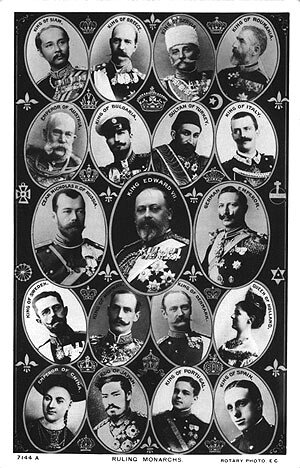
The nine European Monarchs who attended the funeral of King Edward VII of Britain, photographed at Windsor Castle on 20 May 1910. Standing, from left to right: King Haakon VII of Norway, Tsar Ferdinand of Bulgaria, King Manuel II of Portugal, Kaiser Wilhelm II of Germany, King George I of Greece and King Albert I of Belgium. Seated, from left to right: King Alfonso XIII of Spain, King George V of Britain and King Frederick VIII of Denmark.
A monarch is the king or queen at the head of a monarchy. This is a form of government in which a state or polity is ruled or controlled by an individual who typically either inherits the throne by birth or who is elected monarch and who typically rules for life or until abdication. Monarchs’ true powers vary from monarchy to monarchy; on one extreme, they may be autocrats (absolute monarchy), or on the other they may be ceremonial heads of state who exercise little or no power or only reserve power, with actual authority vested in a parliament or other body (constitutional monarchy).

Postcard from 1908 showing nineteen of the world’s reigning monarchs: (left to right) King Rama V/Chulalongkorn of Siam, King George I of Greece, King Peter I of Serbia, King Carol I of Romania, Emperor Franz Joseph of Austria-Hungary, Tzar Ferdinand I of Bulgaria, Sultan Abdul Hamid II of the Ottoman Empire, King Victor Emmanuel III of Italy, Emperor Nicholas II of the Russia, King Edward VII of Britain, Emperor Wilhelm II of Germany, King Gustav V of Sweden, King Haakon VII of Norway, King Frederick VIII of Denmark, Queen Wilhelmina of the Netherlands, Emperor Guangxu of China, Emperor Meiji of Japan, King Manuel II of Portugal and King Alfonso XIII of Spain.

Flag of the British East India Company

Betsy Ross’ first American flag, provided by George Washington

